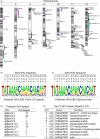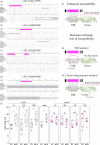Resistance and susceptibility QTL identified in a rice MAGIC population by screening with a minor-effect virulence factor from Xanthomonas oryzae pv. oryzae
- PMID: 32594636
- PMCID: PMC7769240
- DOI: 10.1111/pbi.13438
Resistance and susceptibility QTL identified in a rice MAGIC population by screening with a minor-effect virulence factor from Xanthomonas oryzae pv. oryzae
Abstract
Effective and durable disease resistance for bacterial blight (BB) of rice is a continuous challenge due to the evolution and adaptation of the pathogen, Xanthomonas oryzae pv. oryzae (Xoo), on cultivated rice varieties. Fundamental to this pathogens' virulence is transcription activator-like (TAL) effectors that activate transcription of host genes and contribute differently to pathogen virulence, fitness or both. Host plant resistance is predicted to be more durable if directed at strategic virulence factors that impact both pathogen virulence and fitness. We characterized Tal7b, a minor-effect virulence factor that contributes incrementally to pathogen virulence in rice, is a fitness factor to the pathogen and is widely present in geographically diverse strains of Xoo. To identify sources of resistance to this conserved effector, we used a highly virulent strain carrying a plasmid borne copy of Tal7b to screen an indica multi-parent advanced generation inter-cross (MAGIC) population. Of 18 QTL revealed by genome-wide association studies and interval mapping analysis, six were specific to Tal7b (qBB-tal7b). Overall, 150 predicted Tal7b gene targets overlapped with qBB-tal7b QTL. Of these, 21 showed polymorphisms in the predicted effector binding element (EBE) site and 23 lost the EBE sequence altogether. Inoculation and bioinformatics studies suggest that the Tal7b target in one of the Tal7b-specific QTL, qBB-tal7b-8, is a disease susceptibility gene and that the resistance mechanism for this locus may be through loss of susceptibility. Our work demonstrates that minor-effect virulence factors significantly contribute to disease and provide a potential new approach to identify effective disease resistance.
Keywords: MAGIC; TAL effector; bacterial blight; loss of susceptibility; quantitative resistance; quantitative susceptibility.
© 2020 The Authors. Plant Biotechnology Journal published by Society for Experimental Biology and The Association of Applied Biologists and John Wiley & Sons Ltd.
Conflict of interest statement
The authors declare no conflict of interest.
Figures





References
-
- Ashkani, S. , Rafii, M. , Rahim, H. and Latif, M. (2013) Mapping of the quantitative trait locus (QTL) conferring partial resistance to rice leaf blast disease. Biotechnol. Lett. 35, 799–810. - PubMed
-
- Bai, J. , Choi, S.‐H. , Ponciano, G. , Leung, H. and Leach, J.E. (2000) Xanthomonas oryzae pv. oryzae avirulence genes contribute differently and specifically to pathogen aggressiveness. Mol. Plant Microbe Interact. 13, 1322–1329. - PubMed
-
- Blair, M.W. , Garris, A.J. , Iyer, A.S. , Chapman, B. , Kresovich, S. and McCouch, S.R. (2003) High resolution genetic mapping and candidate gene identification at the xa5 locus for bacterial blight resistance in rice (Oryza sativa L.). Theor. Appl. Genet. 107, 62–73. - PubMed
Publication types
MeSH terms
Substances
Supplementary concepts
LinkOut - more resources
Full Text Sources
Research Materials
Miscellaneous

